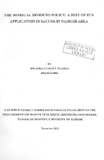| dc.description.abstract | SACCOs are significant financial institutions especially to individuals who cannot access finances from banks due to lack of collateral, their low incomes or banks other regulations. By members coming together to form an entity and mobilize their own savings, and then guarantee each other, they are able to secure credits. These kinds of institutions have grown into giant organizations posting large surpluses. If these surpluses are paid out as dividends without considerations of day to day cash requirements, it would cripple the operations of these institutions whereas if the SACCOs held excess liquidity, it would be a sign of inefficiency by the Finance Manager. Deciding the amounts of earnings to pay out as dividends one of the major decisions that a firm manager faces. Dividend policy determines the extent of internal versus external financing by a firm. (Gordon 1959).
This study was aimed at assessing whether SACCOs on realizing surpluses for the year, take into account funding of positive NPV projects before paying out cash dividends, to assess whether SACCOS have dividend policies in place and if so, whether they are being followed during dividend decisions and to assess whether there are viable institutions where SACCOs can borrow to fund positive NPV projects.
The study was a descriptive survey and was conducted in Nairobi area. Primary data collected through questionnaires which had four sections, section 1 dealt with respondents’ information, section 2 with dividend information, section 3 with loaning information and section 4 dealt with borrowing information.
The list of SACCOs used as respondents was obtained from the Ministry Of Cooperative Development And Marketing. A sample of 50 SACCOs was selected through random sampling method and the questionnaire administered to them through drop and pick method. Data was analyzed using descriptive statistics model of SPSS version 17 package.
The findings were that SACCOs give priority to positive NPV projects on realizing surpluses for the year before paying dividends. It was also found that SACCOs have dividend policies in place and they follow them during dividend payments. The study also found that there exists viable institutions where SACCOs can borrow for on-lending purposes.
The study recommends that SACCOs should have up to date dividend policies in place and be reviewing them as situations demand. It also recommends SACCOs to develop policies of hedging the repayment periods of their borrowing against their on-lending repayment periods. The SACCOs should also have a clear policy on their lending interest rates and these interest rates should take into account related costs and the expected contribution margins. | en_US |

